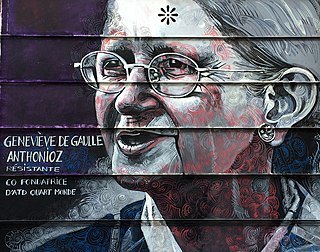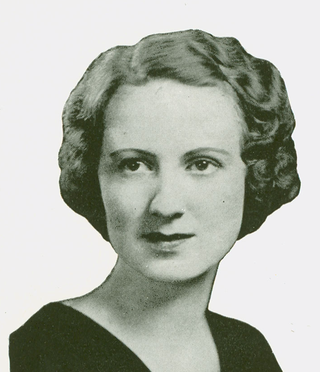Jeanne L'Herminier | |
|---|---|
| Born | 15 October 1907 Nouméa |
| Died | 7 March 2007 Vanves |
| Occupation | French Resistance fighter |
| Awards |
|
Jeannette L'Herminier (15 October 1907 - 7 March 2007 [1] ) was a French Resistance fighter and deportee.
Jeanne L'Herminier | |
|---|---|
| Born | 15 October 1907 Nouméa |
| Died | 7 March 2007 Vanves |
| Occupation | French Resistance fighter |
| Awards |
|
Jeannette L'Herminier (15 October 1907 - 7 March 2007 [1] ) was a French Resistance fighter and deportee.
She was born into a naval family at Nouméa and joined the Resistance around the time of the Vichy fleet scuttling itself at Toulon, which her naval officer brother escaped. On 19 September 1943 the Gestapo arrested her and her mother-in-law in Paris for hiding an American airman and belonging to the Buckmaster networks. Jeannette was deported in February 1944 to Ravensbrück concentration camp, a camp for women north of Berlin. There she began creating cut-out silhouettes of her fellow prisoners using scraps from newspapers and cardboard boxes recovered in the Holýšov Kommando, a munitions factory where she was a forced-labourer. To escape the horrors of the camp, she embellished her subjects to show them as they ought to be. She produced more than 150 works, created and saved thanks to often-dangerous assistance from the other prisoners, notably Elisabeth Barbier, who got most of the drawings out of Ravensbrück.
She was made an officer of the Légion d'honneur and awarded the Croix de guerre 1939-1945 and the Médaille de la Résistance. After recovering most of these drawings post-war, in 1987 she gave them to the Musée de la Résistance et de la Déportation in the Citadelle de Besançon and the Musée de l'Ordre de la Libération in Paris, with the former mounting the first exhibition of them in Strasbourg in 2011, with 71 on show. [2]
She died in Vanves.

Germaine Tillion was a French ethnologist, best known for her work in Algeria in the 1950s on behalf of the French government. A member of the French resistance, she spent time in the Ravensbrück concentration camp.

Geneviève de Gaulle-Anthonioz was a member of the French Resistance and served as president of ATD Quart Monde. Her uncle was General Charles de Gaulle.

Laure Diebold, sometimes written Laure Diebolt was a high-profile female member of the French Resistance during World War II. She was also the private secretary of Jean Moulin before being arrested then deported from 1943 to 1945 to the Nazi camp of Auschwitz, Ravensbrück and finally Buchenwald. Moreover, she is one of only six female resistants to be awarded the title Compagnon de la Libération.
Brigitte Friang was a French journalist, writer and French Resistance member.
Gertrude Mary Lindell, Comtesse de Milleville, code named Marie-Claire and Comtesse de Moncy, was an English woman, a front-line nurse in World War I and a member of the French Resistance in World War II. She founded and led an escape and evasion organization, the Marie-Claire Line, helping Allied airmen and soldiers escape from Nazi-occupied France. The airmen were survivors of military airplanes shot down over occupied Europe. During the course of the war, Lindell was run over by an automobile, shot in the head, imprisoned twice, and captured and sent to Ravensbrück concentration camp in Nazi Germany. Her son Maurice was captured and tortured. Her son Octave (Oky), also captured, disappeared and presumably died in a German concentration camp.
The Groupe du musée de l'Homme was a movement in the French resistance to the German occupation during the Second World War.
Yvonne Oddon (1902–1982) was one of the leaders in the reformation of French libraries and a member of the French Resistance in World War II.

Fort de Romainville, was built in France in the 1830s and was used as a Nazi concentration camp in World War II.

Virginia d'Albert-Lake was a member of the French Resistance during World War II. She worked with the Comet Escape Line. She and her husband Philippe helped 67 British and American airmen evade German capture. She was arrested on June 12, 1944 and imprisoned by the Germans in Ravensbrück concentration camp and other camps for the remainder of the war.
Violette Lecoq was a French nurse, illustrator, and a resistance member during World War II. She is known for her drawings from the Ravensbrück concentration camp, which were also used as evidence at the first Ravensbrück Trials in 1946.
Léon Delarbre was a painter, museum curator, and World War II resistance fighter. After a career as a museum conservator and teacher in his hometown of Belfort, he joined the French resistance in 1941. Arrested in 1944, he was held in a series of concentration camps where he sketched scenes from camp life. These drawings have been widely used to illustrate the horrors of camp life.
Claude Rodier was a physicist, teacher and staff sergeant in the Mouvements Unis de la Résistance (MUR), part of the French Resistance in Auvergne, France.

Yvonne Chollet was a teacher in Vendôme, France, who surveilled the movement of German equipment on behalf of the French Resistance and reported her findings to Allied forces during World War II. Arrested by the Gestapo in May 1943, she was imprisoned at Blois, Orléans, Romainville, and Compiègne before being deported to the Nazi concentration camp near the village of Ravensbrück in northern Germany, where she died the following year.

France Hamelin, born France Aline Haberer, was a French artist, a militant pacifist, and a member of the French Resistance during the Second World War.

Paulette Duhalde was a French Resistance fighter, who operated under the alias of "Jojo" with the Jeanne Network in France's Normandy region during World War II. Betrayed to the Gestapo by a spy within the network, she was arrested, tried, sentenced to five years in prison, and jailed at Fresnes before being deported to a prison facility in Aachen, Germany. Subsequently transferred to the prison at Cottbus near Leipzig, she was then transported, in 1944, to the Nazi concentration camp in Germany known as Ravensbrück. She died there on 23 April 1945.
Anna Garcin-Mayade was a French painter and a member of the French Resistance during the Second World War.
Eva Tichauer was a German Jewish doctor and Holocaust survivor.
The Convoi des 31000 or Convoy of the 31000s was a deportation convoy that left Romainville, France, for Auschwitz Concentration Camp on 24 January 1943. The women who were transported were mostly Communist Party members or Resistance fighters. Its name stemmed from the fact that the women were assigned numbers between 31625 and 31854 when they reached Auschwitz. It was the only convoy to transport women of the French Resistance to Auschwitz. Out of 230 women who arrived at the concentration camp, only 49 survived their ordeal. A number of women from the convoy testified against the Nazis after the war, wrote autobiographies, were awarded the Legion of Honour or were decreed to be Righteous Among the Nations.

Émilie Tillion was a French writer and art critic. Tillion is known for her work on the popular "Les Guides Bleus" and as a member of French Resistance during the Second World War.
Alfonsina Bueno Vela (1915–1979) was a Spanish activist who joined the French Resistance in 1941 and became part of the Ponzán group. With her husband Josep Ester i Borràs and daughter Angelina she ran a house helping airmen on escape lines. After being arrested by the Gestapo, she was deported to Ravensbrück concentration camp in Germany, under the Nacht und Nebel directive. Nazi doctors performed medical experiments upon her without her consent. Bueno's work in the resistance movement was celebrated by the British, French and US governments.